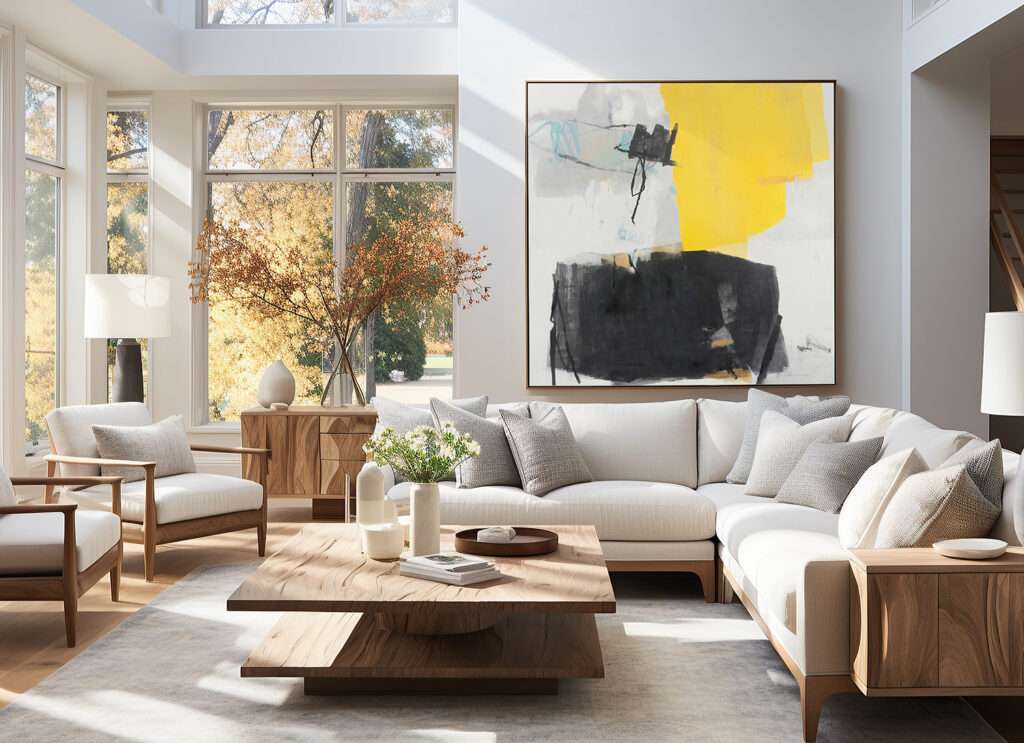Art has the unique ability to transform a space, making it feel more personal, expressive, and dynamic. When it comes to creating a bold, memorable look, large-scale art is a powerful tool that can completely change the atmosphere of a room. Whether it’s a stunning canvas painting, an oversized sculpture, or an intricate photograph, large-scale art commands attention and sets the tone for the entire space.
At Scale & Structure, we believe that incorporating large-scale art into your home design can elevate your interiors and make a lasting impact. In this guide, we’ll walk you through how to make a statement with large-scale art and how to incorporate it into your space in a way that feels balanced, stylish, and personal.

1. Choose Art That Speaks to You
Art Should Reflect Your Personality and Style
Before diving into the technicalities of placing large-scale art, it’s crucial to choose pieces that resonate with your tastes and lifestyle. Whether you’re drawn to abstract paintings, landscapes, photography, or contemporary sculptures, make sure the artwork reflects your unique aesthetic.
- Consider the Mood: Think about the mood you want to create in the space. For a calming effect, soft, muted colors or serene landscapes may work best. If you’re aiming for a vibrant, energetic atmosphere, bold, bright colors and dynamic shapes might be more fitting.
- Art as an Extension of Your Style: Your art should complement the overall style of the room—whether it’s modern, eclectic, minimalist, or traditional. Don’t be afraid to mix different styles, but make sure they work cohesively together.
Tip: Personal Connection
Opt for art that you personally connect with. It’s not just about how it looks but how it makes you feel when you look at it.
2. Pick the Right Size for Your Space
Proportion is Key
When choosing large-scale art, size matters. The piece should feel proportional to the space it’s in—neither too small nor overwhelmingly large for the room.
- Consider Wall Size: Ideally, large-scale art should take up a significant portion of the wall, but not dominate the entire space. For example, if you’re placing a large painting over a sofa, the artwork should be about two-thirds the width of the furniture.
- Room Dimensions: In a spacious living room, a large-scale piece can be the focal point, but in a smaller room, ensure that the artwork doesn’t overwhelm the space. Aim for a piece that fits within the context of the room’s proportions while making a bold statement.
Tip: Use Grid Measurements
To get a sense of how the piece will look, use painter’s tape to outline the size of the artwork on the wall. This will help you visualize the proportion and spacing before making the final decision.
3. Create a Focal Point
Let the Artwork Become the Centerpiece
Large-scale art naturally draws attention, so it’s important to position it where it can shine. The artwork should be the focal point of the room or wall, around which the rest of the design revolves.
- Above Key Furniture: A large painting or sculpture can be a stunning feature above your sofa, bed, or dining table. These key pieces of furniture provide a natural base for the artwork to feel balanced.
- Statement Walls: Dedicate one wall in the room entirely to art. A statement wall can highlight a single large artwork or a curated collection of pieces that work together.
Tip: Balance with Minimalism
To ensure the art remains the star of the show, keep the rest of the wall and room decor minimal. Avoid over-cluttering the space with too many competing elements, which could detract from the impact of the artwork.
4. Frame It Right
Frame vs. Frameless Art
When it comes to large-scale art, the framing (or lack of framing) can significantly affect the overall look. Choose a frame that complements the art and enhances its visual impact, or go frameless for a more modern, sleek presentation.
- Framed Art: A well-chosen frame can tie the artwork into the room’s color palette and design style. For example, a dark wood frame might suit a traditional or rustic room, while a sleek, thin metal frame can look stunning in a modern or industrial space.
- Frameless Art: For a more contemporary or minimalist vibe, frameless art or stretched canvas art offers a cleaner look that allows the artwork to feel integrated into the wall itself.
Tip: Consider the Material of the Frame
The material and finish of the frame should harmonize with your room’s decor. For example, a matte black frame can bring out the colors of a vibrant, modern piece, while a gold frame can elevate the elegance of a more classical work.
5. Position the Artwork at Eye Level
Height Matters
To ensure the artwork is appreciated and easily viewed, it should be positioned at eye level. Generally, this means the center of the artwork should be about 57 to 60 inches from the floor. This standard height works for most people and ensures the artwork feels integrated into the room.
- Above Furniture: When placing art above furniture like a sofa or console table, position the artwork so that there’s about 6 to 8 inches of space between the top of the furniture and the bottom of the artwork.
- On Empty Walls: For large blank walls, center the artwork on the wall, making sure it’s aligned symmetrically with the space around it.
Tip: Adjust for Room Function
If the room is a reading or sitting area, you may want to lower the art slightly for better viewing. In a dining room, higher placement can allow for unobstructed views while seated.
6. Use Art to Complement or Contrast with Your Interior Colors
Color Harmony or Contrast
Large-scale art has the power to either complement or contrast with the color palette of the room. This choice will depend on the overall mood you want to achieve.
- Complementing Colors: If you have a neutral color scheme or want to create a calming atmosphere, select artwork that aligns with your color palette. Subtle tones in the art can add texture and depth without overpowering the room.
- Contrasting Colors: Alternatively, you can use art to inject bold color into a more neutral space. A bright, colorful piece can create a striking contrast against muted walls and furniture, serving as the room’s focal point.
Tip: Coordinate with Accent Colors
Use the dominant hues in the artwork to influence other design elements in the room, such as throw pillows, rugs, or curtains. This ensures a cohesive look, while the artwork still stands out.
7. Frame a View with Art
Use Art to Enhance Natural Features
If your room has windows with beautiful views, large-scale art can be used strategically to frame or enhance the view. For example, place an oversized piece of art near a window to draw attention to the landscape or to bring nature indoors.
- Layering: Position the artwork so that it creates a layered effect with the outdoor view, giving the room depth and a sense of connection to the outside world.
- Mirrored Art: In rooms with limited natural light, use reflective or mirrored art to bounce light around the room and make the space feel brighter and more expansive.
Tip: Think About Seasons
As seasons change, so do the views outside your window. Consider artwork that transitions with the seasons, using different colors and themes that feel fresh and aligned with the time of year.
8. Consider Lighting for Drama
Highlight Your Artwork with Lighting
Proper lighting can elevate large-scale art, enhancing its impact in the room. Thoughtfully placed lighting can create drama, add dimension, and highlight the artwork’s details.
- Track Lighting: Track lighting or picture lights can be directed to shine on the artwork, making it a focal point of the room.
- Spotlights: For larger pieces, spotlights can highlight the art, creating a gallery-like feel.
Tip: Avoid Direct Sunlight
Direct sunlight can damage artwork over time, so make sure your lighting setup provides enough illumination without exposing your art to harsh sunlight.



